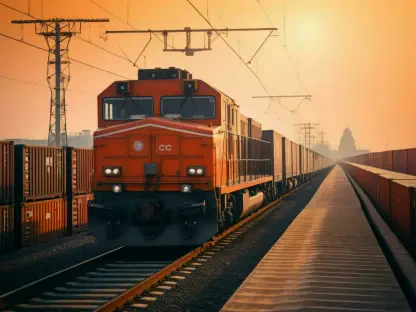The rail freight market is on the brink of significant expansion, with projections estimating its valuation to reach USD 522.4 billion by 2032. This impressive growth is driven by a combination of cost-efficiency, sustainability, and reliability, making rail freight an integral component of global logistics. As industries and economies worldwide strive to optimize their supply chain solutions, rail freight emerges as a pivotal player. This article delves into the current landscape, key growth drivers, regional insights, and future opportunities, while also addressing the challenges that could impact market expansion, offering a comprehensive understanding of the future of rail freight.
Current Landscape of Rail Freight
Historically, rail freight has been a vital component of industrial economies, primarily used for transporting bulk commodities such as coal, minerals, and agricultural products over long distances. These commodities often require the capacity and efficiency that rail transport provides, making it indispensable for certain sectors. Recently, its role in intermodal transportation has been increasing, allowing goods to transition seamlessly among different transport modes like trucks, ships, and trains. This evolution is bolstered by advancements in logistics and supply chain management, which demand flexibility and integration. In 2022, the rail freight sector was already thriving, supported by globalization and the demand for efficient supply chain solutions. As global commerce continues to expand, the importance and value of efficient and reliable rail transport solutions are becoming more prominent.
Significant investments from both governmental and private sectors have optimized the infrastructure, technology, and policies surrounding rail freight. Public-private partnerships (PPPs) have facilitated funding and innovation, leading to the modernization of rail networks and enhancement of services. Governments have recognized the strategic importance of rail freight in boosting economic growth and reducing congestion and emissions associated with road transport. This has resulted in supportive policies and financial incentives aimed at expanding rail networks and improving their efficiency. Meanwhile, private companies have focused on integrating cutting-edge technologies to streamline operations and enhance cargo handling capabilities. This holistic approach has prepared the industry for the anticipated surge in demand and ensures that it remains competitive and forward-looking.
Key Drivers of Growth
In an era of heightened environmental consciousness, rail freight stands out as an energy-efficient and low-emission alternative to road and air transport. Trains produce fewer greenhouse gases per ton-mile, making rail freight an appealing choice for companies committed to achieving their ESG goals. This environmental advantage is increasingly important as businesses and governments strive to reduce their carbon footprints. Companies are under growing pressure to adopt sustainable practices, and choosing rail over more polluting transport modes aligns with this objective. Additionally, governmental regulations and international agreements on climate change are further incentivizing the adoption of greener transport solutions like rail freight.
Extensive investments in new rail networks and the modernization of existing ones are catalysts for market expansion. Emerging economies in Asia and Africa are laying down fresh rail infrastructure to boost trade and connectivity. These regions, experiencing rapid urbanization and industrial growth, require robust transportation systems to support their development. Meanwhile, North America and Europe focus on enhancing the efficiency and capacity of their current rail systems. These infrastructure developments are crucial for supporting the anticipated growth in rail freight demand. In addition to infrastructure, technological advancements are crucial in propelling the industry forward. The digital revolution is making substantial inroads into the rail freight sector. Technologies such as AI, IoT, and blockchain are streamlining operations, cutting transit times, and enhancing cargo tracking. Innovations like automated trains and predictive maintenance are becoming mainstream, pushing the industry forward. These technological advancements are essential for improving efficiency, reliability, and transparency in the rail freight sector, positioning it for sustained growth.
Challenges to Overcome
Despite the optimistic growth projections, the rail freight market must address several significant challenges to achieve its full potential. The capital-intensive nature of rail infrastructure projects can be daunting. Building and maintaining rail networks require substantial financial investments and planning, which can be a barrier to entry for new players and limit the pace of infrastructure development. While public-private partnerships offer a viable solution, harmonizing the interests of diverse stakeholders remains a challenge. Different stakeholders, including governments, private investors, and local communities, may have conflicting priorities that need to be managed to ensure project success. Overcoming these investment challenges is crucial for expanding rail networks and meeting the rising demand for rail freight services.
Rail freight faces stiff competition from road and air transport, which offer certain advantages. Trucks provide greater flexibility and faster last-mile delivery, making them a preferred choice for shorter and more localized routes. Meanwhile, air freight is unrivaled for speed, being the go-to option for high-value and time-sensitive shipments. Continuous innovation and service quality improvement are imperative for rail operators to stay competitive. The rail freight industry must find ways to differentiate itself and offer unique value propositions to customers. This includes enhancing the efficiency of operations, reducing transit times, and improving overall service reliability. Additionally, addressing regulatory and political challenges is essential. The heavily regulated rail freight industry faces varying policies across regions. Political instability and trade disputes can significantly disrupt operations and create uncertainties for stakeholders. Navigating these regulatory and political challenges is essential for ensuring smooth and efficient rail freight operations in a globalized market.
Regional Insights
The North American rail freight market is distinguished by its extensive network and high efficiency levels. The region boasts one of the most comprehensive rail systems globally, with well-established connections across the United States, Canada, and Mexico. Investments in intermodal transportation are rising, fueled by the e-commerce surge and cross-border trade with Canada and Mexico. The growth of online retail has increased the need for efficient and reliable transportation solutions, driving demand for rail freight services. The region’s well-developed infrastructure and strong demand for rail freight services position it for continued growth. North American rail operators are also investing heavily in technology and infrastructure upgrades to enhance service quality and meet the evolving needs of their customers.
Europe’s rail freight sector benefits from initiatives like the Trans-European Transport Network (TEN-T), aimed at establishing a seamless, interconnected rail system across the continent. The TEN-T project seeks to create a unified, high-performance rail network that facilitates efficient and sustainable freight movement across the European Union. Sustainability goals and government incentives further propel market growth. Europe has a strong focus on reducing carbon emissions and promoting green logistics, making rail freight a key component of its transportation strategy. The focus on creating a unified rail network is expected to enhance the efficiency and competitiveness of rail freight in Europe, attracting more businesses to adopt rail transport for their logistical needs.
Future Opportunities
The fusion of rail freight with other transport modes, known as intermodal transportation, offers significant growth prospects. Developing cohesive intermodal solutions can amplify efficiency and extend the market’s reach. By seamlessly integrating rail with road, sea, and air transport, logistics providers can offer comprehensive and flexible transportation solutions that meet diverse customer needs. This intermodal approach can improve cargo handling, reduce transit times, and optimize costs, making it highly attractive for businesses. The growing emphasis on green logistics presents another substantial opportunity. As environmental consciousness grows, rail freight operators can capitalize on their sustainability edge. Initiatives such as carbon-neutral shipping and green logistics can attract environmentally-minded customers who prioritize reducing their environmental impact. By promoting their eco-friendly credentials, rail freight companies can differentiate themselves in a competitive market and appeal to a broader customer base.
Embracing digital technologies is another crucial opportunity for the rail freight industry. Real-time tracking, predictive analytics, and automated operations can elevate efficiency and enhance customer satisfaction, driving industry growth. Advanced technologies enable better visibility and control over cargo movements, reducing delays and improving overall service reliability. Furthermore, expanding networks into underserved regions presents new avenues for growth. Strategic infrastructure investments will be crucial to tapping into these potentials. By establishing new trade corridors and extending rail connectivity, rail freight operators can unlock lucrative markets and support economic development in emerging regions.
Conclusion
The rail freight market is poised for considerable growth, with projections estimating its value to hit USD 522.4 billion by the year 2032. This remarkable increase is spurred by a mix of cost-effectiveness, sustainability, and dependability, positioning rail freight as a critical element in global logistics networks. As businesses and economies around the world seek to streamline their supply chains, rail freight stands out as a vital component. This analysis explores the current state of the market, the key factors driving its expansion, regional trends, and future opportunities. Additionally, it addresses the challenges that might hinder market growth, providing a thorough understanding of the future prospects for rail freight. With its combination of economic benefits and environmental considerations, rail freight is set to play an increasingly important role in meeting the logistics demands of the future.









